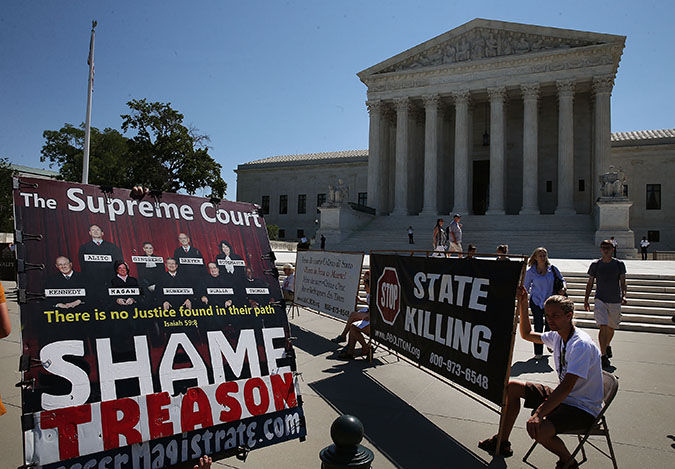In a divided ruling announced June 29, the Supreme Court has upheld the continued use of a controversial drug used in several botched executions in recent years.
In a case from Oklahoma — Glossip v. Gross — the justices voted 5-4 that the drug midazolam can be used in executions without violating the Eighth Amendment’s ban on cruel and unusual punishment.
Midazolam, which is used as part of a multi-drug cocktail, is an anti-anxiety medication that is supposed to have a deeply sedative effect. But the drug failed to perform as expected in at least four prolonged or botched executions over the last two years.
The most high-profile case involved Oklahoma’s attempt to execute convicted murderer Clayton Lockett, who kicked, writhed, groaned and tried to speak for an extended period of time after the lethal injection process had begun, according to eyewitness accounts.
Lockett eventually died of a heart attack 43 minutes after initially being sedated. Officials had decided to halt the execution by the time he died.
At least four states — Oklahoma, Florida, Ohio and Arizona — have adopted the use of midazolam as part of a two- or three-drug lethal injection protocol. The protocol is a way of managing an ongoing global shortage of lethal injection drugs, arising largely from European objections to capital punishment.
Europe’s anti-death penalty stance has limited the production of previously used drugs and halted their export to the U.S., prompting states to seek new drug combinations or explore alternative execution methods, such as firing squads or the gas chamber.
Although the recent Supreme Court ruling was disappointing, it was not unexpected, said Andy Rivas, director of government and community relations for the Archdiocese of Los Angeles. Such a divided vote is a small victory and a move in the right direction, he said, especially for California, which has nearly 750 death row inmates — the most of any U.S. state.
“That’s actually a very good sign for us,” Rivas explained to The Tidings. “There was a time when a vote on something like this would have been 8 to 1, or 7 to 2, so we’re making some strides in terms of being able to convince the judicial leaders of our country that we don’t need to use the death penalty anymore, that the standards for protecting life should be higher, so we’re slowly getting there.”
No executions have been carried out in California since January 2006. But in a recent settlement with families of murder victims, California prison officials have agreed to propose a new single-drug execution method within 90 days of the Supreme Court’s recent ruling.
Whatever the outcome of that settlement, Californians will likely get to vote on the issue in 2016, when a statewide anti-death penalty initiative is expected to be on the ballot, according to Javier Stauring, co-director of the archdiocesan Office for Restorative Justice.
In 2012, Proposition 34 — which sought to replace the death penalty with a life sentence, with no possibility of parole — was defeated by a small margin — 52 to 48 percent.
If a similar measure passes in 2016, California would become the 20th state to outlaw executions, after Nebraska, which voted to abolish the practice in May.
“I truly do believe that, in particular with leadership from the Catholic community, we will get it passed this time,” said Stauring. “And I believe that if we can get it passed in California, which has the largest death row population in the nation, that that would have a very significant impact at the national level.”
He explained that there is “no viable reason to have the death penalty.”
“Pope Francis says that nothing can justify the use of the death penalty; there is no right way to humanely kill another person. … It’s clear that the Church stands against the death penalty, not only because we believe that everybody is made in the image of Christ, but also because we know that for the crime victims, more often than not, it fosters vengeance and does very little to help heal the surviving family members.”
In a March 20 column in The Tidings, Archbishop José H. Gomez wrote that it’s time for the United States to put an end to the death penalty.
“The Catholic Church has been calling for the abolition of the death penalty for more than 40 years,” he wrote.
Although the Catechism states that “governments may impose the death penalty ‘if this is the only possible way of effectively defending human lives against the unjust aggressor,’” Archbishop Gomez emphasized that due to modern-day “advances in law enforcement and criminal justice our society has many ways to punish violent offenders and to prevent them from committing further violence.”
A society that continues to accept the death penalty creates a culture in which citizens think their problems can be solved by violence, he wrote.
“We do not need to kill criminals to defend our society,” he said, adding that “as Christians, we are called to proclaim the Gospel of life and to work so that our criminal justice system always respects the dignity of every human person.”

